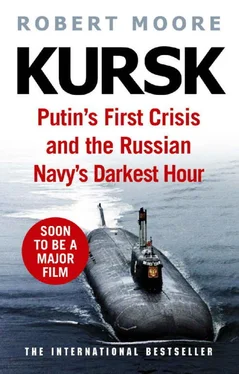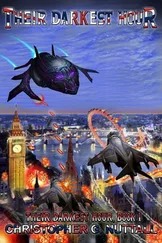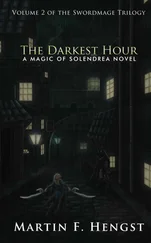I: 6 a.m., THURSDAY, 10 AUGUST
Vidyaevo Garrison
In a gentle curve of the hills, surrounded by pine and birch trees, and sandwiched between pristine lakes and the Arctic Sea, the brutal architecture of a Russian garrison town comes into view with first light. Dawn does no favours for Vidyaevo. Grey concrete apartment blocks squat in the valley, crumbling with neglect, and the roads leading to the central square are blistered and cracked. People live in this lonely corner of the Kola Peninsula only because someone has ordered them to do so. The only civilians allowed are the families of the sailors and naval officers, along with a few hundred local workers needed to support and supply the base. They are provided with documents and special passes to get through the security barricades and the perimeter fence. All other outsiders are strictly forbidden.
There are no bars or cafés, no cinemas or sports clubs in Vidyaevo. There is not even a church or a school. This secret, desolate outpost lies within the Arctic Circle, 80 miles north-west of Murmansk. Moscow sits a thousand miles to the south, and the nearest communities are all other submarine bases. The teenagers of Vidyaevo are sent off to the cities to live with relatives; the elderly have sought sanctuary where the geography and the climate are kinder. Only submariners, their wives and those children too young to be sent elsewhere remain. Those who live in the town say it is a community without a soul. Vidyaevo has 18,000 residents, but no-one calls it home.
During the long, brutal winter, the Arctic wind scythes through the town. There are naval ports along this coast where ropes are strung out along the roadsides to allow pedestrians to stay upright in the icy gales. In the humorous slang of the Northern Fleet, the sub base of Gremikha is also called ‘Flying Dogs’, since the town’s pets have been known to be blown through the air in the fierce wind. The locals wisely stay indoors or cling to the roadside ropes.
Founded in 1968, Vidyaevo is one of a string of such military towns that the Russian Navy built on the Kola Peninsula during the height of the Cold War. For decades, maps of the region showed no markings at all for the submarine bases. Careful scrutiny of Soviet-era charts reveals just a mass of inlets and fjords and an enigmatic coast-line. Only some of the larger towns are marked with mysterious names that hint at military settlements: Base-35, Severomorsk-7, Shipyard-35, Murmansk-60. The official thinking was that if someone had to look at a map or ask directions, he had no business going there in the first place. For much of its short history, Vidyaevo did not officially exist.
The town was named after Fyodor Vidyaev, an impoverished trawlerman from the Volga region who became a legend during the Second World War as a fearless submarine captain. On 8 April 1942 his boat was severely damaged by a German destroyer, and Vidyaev attempted to limp home on the surface. With no power, he ordered the crew to stitch together a sail, tying it between the deck and the raised periscope. Unable to reach land, just as the crew was preparing to scuttle the submarine they were rescued by another Soviet ship. After further combat patrols, each of them notching up successes against German shipping, in the summer of 1943 Vidyaev’s Shch-422 submarine was lost with all hands. In the skilled words of Stalin’s propagandists, Vidyaev made for a potent legend: the young fisherman from the south whose cunning and courage swung the battle in the Arctic against the Nazis.
A solitary road leads to the Vidyaevo base, winding through the low contours of the Kola Peninsula. The only signs of life along the route are the dwarf birch trees, frozen for much of the year, their growth stunted by the weight of snow and ice upon them. That they grow at all in this climate is an extraordinary achievement. The stark beauty of the land seems enhanced by knowledge of the destructive military power and nuclear weaponry that lie at the end of the road. For security reasons, no overhead lights and no markings delineate the route – there’s just a strip of asphalt snaking through the woods. Reflective patches nailed to roadside trees at chest height assist drivers down the potholed route.
Most nights, an eerie silence falls over the base, although down at the docks the steady hum of pier-side generators is punctuated by the pacing of guards trying to stay warm. They protect the submarines around the clock against theft or espionage. In the town at night, the only noise is the occasional bark of a wild dog searching for scraps of food.
Shortly after dawn on 10 August that silence was broken as the base burst into life. In apartments and barracks, sailors quickly dressed and packed one spare set of clothes in their canvas bags. Minutes later, the young men emerged, striding out down the streets, shaking off the early-morning cold. Several buses and trucks arrived to take them down to the docks.
Twenty-four-year-old Sergei Tylik was among those early risers. Like many naval officers, his dislike of life on the base was outweighed by the sense of achievement he felt whenever he headed out to sea. As far as he was concerned, he travelled between two different worlds. There was the shame of living in a dilapidated and primitive base no-one cared about, and then there was the pride of working on one of Russia’s premier nuclear-powered submarines. The officers used to joke about why they liked the strenuous work aboard the Kursk so much: Why do we want to be on patrol? Because it means we’re no longer ashore.
The son of a submariner, Sergei had spent all his life on the Kola Peninsula. Serving in the Northern Fleet was like joining the family business. As a boy, he had loved to listen to officers gathered at his home talk of their adventures at sea. When his father was due to return from long voyages, Sergei’s mother would take him down to the pier to wait for the first glimpse of the submarine. His earliest memories were of standing at the docks, wrapped up against the wind, eagerly scanning the horizon.
Sergei said a brief goodbye to his wife, Natasha, and to Lisa, their nine-month-old baby. A lingering farewell was reserved for longer voyages; this was a quick exercise, less than a week, and the submarine would not even leave home waters.
Moored to Pier Number Eight, lying low and menacing in the water, loomed the principal source of Sergei’s pride. Russia couldn’t offer much these days to inspire a young man with enthusiasm, but this submarine was different. With her huge double hulls and massive steel bulkheads dividing her into a series of sealed compartments, the Kursk was described by her designers as unsinkable.
She was the seventh of a class of boats that the Russian Navy designates as an Antey 949A type and NATO calls an ‘Oscar II’. Whatever you call these subs, they are easily the largest class of attack submarine ever built. Oscar IIs are designed to play a very specific role in combat: to hunt down and destroy American aircraft carriers and their battle groups. Their main weapon is the SS-N-19 Shipwreck, a supersonic anti-ship cruise missile designed to fly so fast and low that it can penetrate even the best Western naval air defences.
Few other ships have been built amid as much turmoil as the Kursk was. During the three years of her construction, the nation she was designed to defend had self-destructed. She was planned under Communism, approved during Mikhail Gorbachev’s era of reforms, and her keel was laid down under Boris Yeltsin. In the end, she was commissioned and launched not into the Soviet Navy but the Northern Fleet of the Russian Federation.
The construction of the Kursk began in the summer of 1992, on the slips of a White Sea shipyard in Severodvinsk, near Archangel. A canvas roof shielded the project from American satellite reconnaisance. Her design dated back to the late 1970s, when the Soviet Union hoped that a new class of giant attack submarine would guarantee victory in any future naval battle. She was a formidable machine the height of a four-storey building and longer than two football fields. Submerged, she displaced 23,000 tons. Engineering on this scale was more than just impressive – it seemed outright audacious that anyone could design and build a submarine of this size.
Читать дальше












